Street Names of Drugs
It is very common for various drugs, including ‘illegal’ and prescription drugs to have street names’. These names change constantly. For a current listing cross reference, here is a good link from the National Institute of Chemical Dependency.
What Common Drugs Look Like
To help you identify certain drugs, like pills and other substances, here are descriptions for some types of the most commonly abused drugs:
- Marijuana can appear brown, gray or green. It may contain leaves, stems or flowers from the plant.
- Heroin can look like a white or off-white powder. “Black tar” heroin is darker in color and may be sticky or hard. Largely, the color of the heroin will depend upon the variety in question. Heroin can also come in a light brown, powdered form.
- Cocaine is a fine, white powder that is usually snorted or injected (after being mixed with water).
- Crack cocaine looks like a rock or crystals; it is generally white or off-white and can vary greatly in size. Crack cocaine is generally smoked.
- Amphetamines (”uppers”) can look like tablets, crystals, capsules or white powder. Amphetamine capsules or tablets come in a wide range of colors and sizes. Generally, amphetamines are taken orally or snorted.
- Barbiturates (”downers”) can come in a liquid form, as well as capsules or tablets of various colors. Barbiturates are usually taken orally.
- Crystal meth has no color or odor. It comes in chunks or crystal-like forms.
LSD usually comes on small squares of paper, known as “blotting paper.” These pieces of paper are often brightly colored or have images printed on them. LSD is also available in liquid form. - Mushrooms look like what they are – dried mushrooms. Hallucinogenic mushrooms look nearly identical to dried mushrooms you would find in a grocery store.
Amphetamine and Methamphetamine
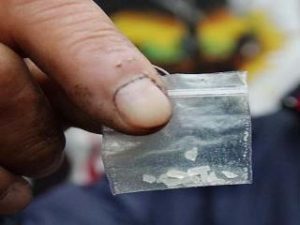
Amphetamine, commonly referred to as “speed”, was first marketed in the 1930’s as Benzedrine in an over-the-counter inhaler to treat nasal congestion. By 1937, amphetamine was available by prescription in tablet form. During World War II, amphetamine was widely used to keep soldiers alert and both dextroamphetamine (Dexedrine) and methamphetamine (Methedrine) became readily available. Until recent years, amphetamines were commonly prescribed for weight loss. But due to a high potential for abuse and addiction, they are now reserved for limited treatment of attention-deficit hyperactivity disorder (ADHD), narcolepsy (attacks of uncontrollable sleepiness), and Parkinson’s disease.
Because amphetamines increase alertness, energy, and a sense of well-being, they are sometimes used illicitly by truck drivers, shift workers, students, and athletes. They are also commonly abused as appetite suppressant. Amphetamines are found in a wide variety of shapes and forms and also have a wide variety of sources. Thus, even experienced users may be unable to tell which drug they have actually taken.
Amphetamines are found in both prescription form and in illicitly manufactured forms. Prescription amphetamines are usually found in the form of tablets or capsules – in a variety of shapes and colors.
Though prescription amphetamines can be found on the street, typical street amphetamine is manufactured in illicit laboratories. This form of the drug has a higher potential for abuse and addiction than the prescription forms. Illicit amphetamine is found in varied colors, but is normally a white crystalline powder that is sniffed. It is also commonly converted to a liquid form and injected.
Methamphetamine is an addictive stimulant drug that strongly activates certain systems in the brain. Methamphetamine is closely related chemically to amphetamine, but the central nervous system effects of methamphetamine are greater. Both drugs have some medical uses, primarily in the treatment of obesity, but their therapeutic use is limited.
Methamphetamine is made in illegal laboratories and has a high potential for abuse and dependence. Street methamphetamine is referred to by many names, such as “speed,” “meth,” and “chalk.” Methamphetamine hydrochloride, clear chunky crystals resembling ice, which can be inhaled by smoking, is referred to as “ice,” “crystal,” and “glass.”
More information: http://www.drugabuse.gov/Infofax/methamphetamine.html
Cocaine

Cocaine is a powerfully addictive drug of abuse. Once having tried cocaine, an individual cannot predict or control the extent to which he or she will continue to use the drug.
The major routes of administration of cocaine are sniffing or snorting, injecting, and smoking (including free-base and crack cocaine). Snorting is the process of inhaling cocaine powder through the nose where it is absorbed into the bloodstream through the nasal tissues. Injecting is the act of using a needle to release the drug directly into the bloodstream. Smoking involves inhaling cocaine vapor or smoke into the lungs where absorption into the bloodstream is as rapid as by injection.
“Crack” is the street name given to cocaine that has been processed from cocaine hydrochloride to a free base for smoking. Rather than requiring the more volatile method of processing cocaine using ether, crack cocaine is processed with ammonia or sodium bicarbonate (baking soda) and water and heated to remove the hydrochloride, thus producing a form of cocaine that can be smoked. The term “crack” refers to the crackling sound heard when the mixture is smoked (heated), presumably from the sodium bicarbonate.
There is great risk whether cocaine is ingested by inhalation (snorting), injection, or smoking. It appears that compulsive cocaine use may develop even more rapidly if the substance is smoked rather than snorted. Smoking allows extremely high doses of cocaine to reach the brain very quickly and brings an intense and immediate high. The injecting drug user is at risk for transmitting or acquiring HIV infection/AIDS if needles or other injection equipment are shared.
More information: http://www.nida.nih.gov/DrugPages/Cocaine.html
Marijuana

Marijuana is the most commonly used illicit drug in the United States. (Please see below for K2 and other versions of synthetic marijuana aka pot)
A dry, shredded green/brown mix of flowers, stems, seeds, and leaves of the hemp plant Cannabis sativa, it usually is smoked as a cigarette (joint, nail), or in a pipe (bong). It also is smoked in blunts, which are cigars that have been emptied of tobacco and refilled with marijuana, often in combination with another drug. Use also might include mixing marijuana in food or brewing it as a tea. As a more concentrated, resinous form it is called hashish and, as a sticky black liquid, hash oil.
Marijuana smoke has a pungent and distinctive, usually sweet-and-sour odor. There are countless street terms for marijuana including pot, herb, weed, grass, widow, ganja, and hash, as well as terms derived from trademarked varieties of cannabis, such as Bubble Gum®, Northern Lights®, Juicy Fruit®, Afghani #1®, and a number of Skunk varieties.
The main active chemical in marijuana is THC (delta-9-tetrahydrocannabinol). The membranes of certain nerve cells in the brain contain protein receptors that bind to THC. Once securely in place, THC kicks off a series of cellular reactions that ultimately lead to the high that users experience when they smoke marijuana.
More information: http://www.nida.nih.gov/Infofax/marijuana.html
Opiates

Opiates are commonly prescribed because of their effective analgesic or pain relieving properties. Many studies have shown that, properly managed, medical use of opiate analgesic drugs is safe and rarely causes clinical addiction, which is defined as compulsive, often uncontrollable use. Taken exactly as prescribed, opiates can be used to manage pain effectively.
Among the drugs that fall within this class – sometimes referred to as narcotics – are morphine, codeine, and related drugs. Morphine is often used before or after surgery to alleviate severe pain. Codeine is used for milder pain.
Other examples are synthetic opiates that can be prescribed to alleviate pain and include oxycodone (OxyContin-an oral, controlled release form of the drug); propoxyphene (Darvon); hydrocodone (Vicodin); hydromorphone (Dilaudid); and meperidine (Demerol), which is used less often because of its side effects. In addition to their effective pain relieving properties, some of these drugs can be used to relieve severe diarrhea (Lomotil, for example, which is diphenoxylate) or severe coughs (codeine). The synthetic opiate drugs are not detected in the standard five-panel drug test; only morphine and codeine are detected in the standard five-panel test.
Opiates act by attaching to specific proteins called opioid receptors, which are found in the brain, spinal cord, and gastrointestinal tract. When these drugs attach to certain opioid receptors in the brain and spinal cord they can effectively block the transmission of pain messages to the brain.
In addition to relieving pain, opiate drugs can affect regions of the brain that mediate what we perceive as pleasure, resulting in the initial euphoria that many opiates produce. They can also produce drowsiness, cause constipation, and, depending upon the amount of drug taken, depress breathing. Taking a large single dose could cause severe respiratory depression or be fatal.
Opiates may interact with other drugs and are only safe to use with other drugs under a physician’s supervision. Typically, they should not be used with substances such as alcohol, antihistamines, barbiturates, or benzodiazepines. These drugs slow down breathing, and their combined effects could risk life-threatening respiratory depression.
Chronic use of opiates can result in tolerance to the drugs so that higher doses must be taken to obtain the same initial effects. Long-term use also can lead to physical dependence – the body adapts to the presence of the drug and withdrawal symptoms occur if use is reduced abruptly.
Heroin is a highly addictive drug, and its use is a serious problem in America. Recent studies suggest a shift from injecting heroin to snorting or smoking because of increased purity and the misconception that these forms of use will not lead to addiction.
Heroin is processed from morphine, a naturally occurring substance extracted from the seedpod of the Asian poppy plant. Heroin usually appears as a white or brown powder. Street names for heroin include “smack,” “H,” “skag,” and “junk.” Other names may refer to types of heroin produced in a specific geographical area, such as “Mexican black tar.” Use of heroin is detected by the presence of morphine in the drug test.
http://www.drugabuse.gov/Infofax/heroin.html
http://www.drugabuse.gov/Infofax/PainMed.html
Phencyclidine (PCP)
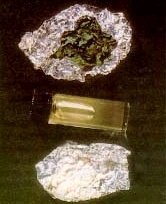
PCP (phencyclidine) was developed in the 1950s as an intravenous anesthetic. Use of PCP in humans was discontinued in 1965, because it was found that patients often became agitated, delusional, and irrational while recovering from its anesthetic effects. PCP is illegally manufactured in laboratories and is sold on the street by such names as “angel dust,” “ozone,” “wack,” and “rocket fuel.” “Killer joints”and “crystal supergrass” are names that refer to PCP combined with marijuana. The variety of street names for PCP reflects its bizarre and volatile effects.
PCP is a white crystalline powder that is readily soluble in water or alcohol. It has a distinctive bitter chemical taste. PCP can be mixed easily with dyes and turns up on the illicit drug market in a variety of tablets, capsules, and colored powders. It is normally used in one of three ways: snorted, smoked, or eaten. For smoking, PCP is often applied to a leafy material such as mint, parsley, oregano, or marijuana.
PCP is addicting; that is, its use often leads to psychological dependence, craving, and compulsive PCP-seeking behavior. It was first introduced as a street drug in the 1960s and quickly gained a reputation as a drug that could cause bad reactions and was not worth the risk. Many people, after using the drug once, will not knowingly use it again. Yet others use it consistently and regularly. Some persist in using PCP because of its addicting properties. Others cite feelings of strength, power, invulnerability and a numbing effect on the mind as reasons for their continued PCP use.
People who use PCP for long periods report memory loss, difficulties with speech and thinking, depression, and weight loss. These symptoms can persist up to a year after cessation of PCP use. Mood disorders also have been reported. PCP has sedative effects, and interactions with other central nervous system depressants, such as alcohol and benzodiazepines, can lead to coma or accidental overdose
K2 K3 K4 etc (Synthetic Marijuana)
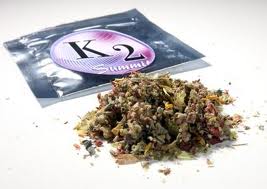
K2 is a popular new drug that has effects just like marijuana. Many copy cat products that contain the same chemicals are being sold on the internet, in boutique stores, gas stations and smoke shops. It is usually smoked in a small pipe or a cigarette. Scientifically you may hear this referred to as JWH-018, JWH-073, or similar.
What does it look like?
K2 and other alternatives look like potpourri and consists of leaves, stems and petals of aromatic plants such as licorice. These crushed plants are “laced with” the active chemicals and are sold as “incense” or “legal highs”. The packages are typically brightly colored, have psychedelic patterns and are sachets or Mylar® envelopes about the size of a playing card. Products are sold under various names including K2, Spice, Space, Pep-Spice, K1, K3, K4, C1, Kryp2nite, Mr. Smiley, Genie, Smoke, Pot-pourri, Buzz, Mystery, Earthquake, Ocean Blue, Cloud 10, Groove, and Yucatan Fire, and others. Just because they may be labeled ‘natural’ or herbal alternatives, they cannot be considered safe!
Why should we be concerned about K2?
The drugs in K2 are synthetic chemicals made in a lab and their safety has not been studied. Side effects are not well known and there are increasing reports of users getting sick and showing up in the emergency room.
Since the start of 2010, the American Association of Poison Control Centers has received nearly 2,000 reports of people who became ill after smoking K2, compared to about a dozen in 2009. Poison control officials described some of the symptoms as “life-threatening.” Any drug that affects intoxication can interfere with behavior, school, work, and relationships. Individuals behind the wheel after using this drug are being arrested for driving under the influence (DUI).
Is it legal?
The drugs in K2 are illegal in the United States, and it can be hazardous to the user and others.
What might you observe if someone is using K2?
Immediate physical affects after smoking
- Dizziness
- Laughing
- Confusion
- Disorientation
- Silly behavior
- Heightened anxiety
- Bloodshot eyes
- Increased pulse
- Cannot remember recent events or conversations
Will regular drug tests and/or drug tests available at the pharmacy find K2?
No – routine drug tests from laboratories and drug test kits available at pharmacies currently do not include testing for the synthetic cannabinoids present in K2. This is a specialty test that must be specifically requested at KT Health Clinic.
Here is an excellent article on the dangers of K2-
http://news.yahoo.com/s/hsn/20101111/hl_hsn/fakemarijuanausersshowingupinemergencyrooms
http://www.drugabuse.gov/NIDAHome.html
Mephedrone/MDPV
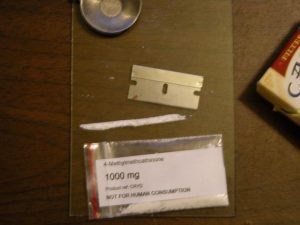
**Please NOTE – there are many new names and ‘products’ that are being sold that have this and other very dangerous substances as ingredients ie ‘Jewelry Cleaner’, ‘Xplosion’, ‘toy cleaner’, ‘decorative sand’ etc
Mephedrone, also known as 4-methylmethcathinone (4-MMC), or 4-methylephedrone, is a syntheticstimulant and entactogendrug of the amphetamine and cathinone classes. (Cathinone is the parent substance.) Slang names include meph, drone, MCAT, ‘Meow-Meow’ and kati. It is reportedly manufactured in China and is chemically similar to the cathinone compounds found in the khat plant of eastern Africa. It comes in the form of tablets or a powder, which users can swallow, snort or inject, producing similar effects to MDMA, amphetamines and cocaine.
As well as producing the intended stimulant effects, negative side effects occur when mephedrone is used, with teeth grinding being the most common. The metabolism of mephedrone has been studied in rats and humans, with the metabolites being able to be detected in urine after usage. Nothing is known about the potential neurotoxicityof mephedrone, but scientists have suggested possible dangers associated with its use based on its similarity to other drugs. Several people have died after consuming mephedrone, but some deaths that the media attributed to the drug were later determined to have been caused by other factors.
Kratom (Synthetic Opiates)
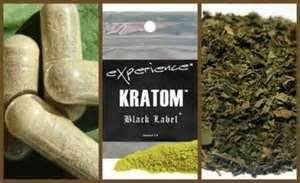
At low doses, kratom produces stimulant effects with users reporting increased alertness, physical energy, talkativeness, and sociable behavior. At high doses, users experience sedative effects. Effects occur within 5-10 minutes of ingestion and last for 2-5 hours. Kratom ingestion can lead to addiction. Cases of psychosis resulting from the use of kratom have been reported, where individuals addicted to kratom exhibited psychotic symptoms, including hallucinations, delusion and confusion. Withdrawal affects include symptoms of hostility, aggression, mood swings, runny nose, achy muscles and bones, and jerky movement of limbs.
Kratom’s effects on the body include nausea, itching, sweating, dry mouth, sweating, constipation, increased urination, and loss of appetite. Long-term users of kratom have experienced anorexia, weight loss, insomnia, skin darkening, dry mouth, frequent urination, and constipation. The dominant effects of kratom are similar to psycho stimulant drugs.
According to the DEA, there is no legitimate medical use for kratom in the United Staes according to the DEA. It is marketed on the internet as an ‘alternative medicine’ for use as a pain killer, medicine for diarrhea, and for other ailments, and the treatment of opiate addiction. It is mainly abused orally as a tea. Chewing kratom leaves is another method of abuse.
Prescription Medications
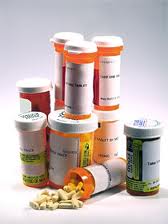
Prescription drug abuse is a growing trend in America, affecting families, schools and workplaces. According to the National Institute on Drug Abuse (NIDA), after marijuana, prescription and non-medical use of over-the-counter medication account for most of the commonly abused drugs among 12th Graders in America.
Three types of prescription drugs are abused most often:
- Opioids—prescribed for pain relief
- CNS depressants—barbiturates and benzodiazepines prescribed for anxiety or sleep problems (often referred to as sedatives or tranquilizers)
- Stimulants—prescribed for attention-deficit hyperactivity disorder (ADHD), the sleep disorder narcolepsy, or obesity.
Inhalants / Huffing
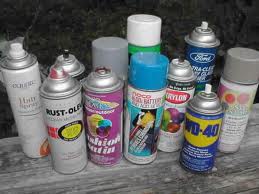
Inhalants are breathable chemical vapors that users intentionally inhale because of the chemicals’ mind-altering effects. The substances inhaled are often common household products that contain volatile solvents, aerosols, or gases.
STREET NAMES – whippets, poppers, snappers
Most inhalants produce a rapid high that resembles alcohol intoxication. If sufficient amounts are inhaled, nearly all solvents and gases produce a loss of sensation, and even unconsciousness. Irreversible effects can be hearing loss, limb spasms, central nervous system or brain damage, or bone marrow damage. Sniffing high concentrations of inhalants may result in death from heart failure or suffocation (inhalants displace oxygen in the lungs).
In 2009, 2.1 million Americans age 12 and older had abused inhalants. Source: National Survey on Drug Use and Health (Substance Abuse and Mental Health Administration Web Site). The NIDA-funded 2010 Monitoring the Future Study showed that 8.1% of 8th graders, 5.7% of 10th graders, and 3.6% of 12th graders had abused inhalants at least once in the year prior to being surveyed
Mushrooms
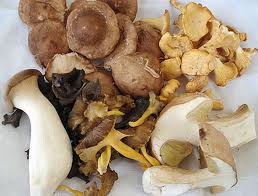
What are the street names/slang terms? Caps, Magic mushrooms, Mushrooms, Psilocybin & Psilocyn, Shrooms.
Psilocybin and psilocyn are the hallucinogenic principles contained in certain mushrooms. These “magic” mushrooms are generally grown in Mexico andCentral America and have been used in native rituals for thousands of years. Psilocybin is structurally similar to serotonin, and produces its effects by disrupting normal functioning of the serotonin system. They look like dried mushrooms. Mushrooms can be eaten, brewed and consumed as tea.
Short-term effects – once ingested, mushrooms generally cause feelings of nausea before the desired mental effects appear. The high from using magic mushrooms is mild and may cause altered feelings and distorted perceptions of touch, sight, sound and taste. Other effects can include nervousness and paranoia. Effects can be different during each use due to varying potency, the amount ingested, and the user’s expectations, mood, surroundings, and frame of mind. On some trips, users experience sensations that are enjoyable. Others can include terrifying thoughts, and anxiety, fears of insanity, death, or losing control.
Long-term effects – some magic mushroom users experience “flashbacks”, or hallucinogen persisting perception disorder (HPPD), which are reoccurrences of hallucinations long after ingesting the drug. The causes of these effects, which in some users occur after a single experience with the drug, are not known.
Steroids
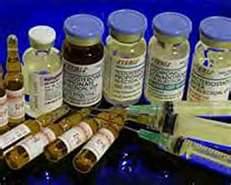
The abuse of steroids is not only a problem among sports professionals and athletes but it has also become prevalent among adult individuals (men and women) and teenagers who want to muscle size and reduce body fat.
Salvia
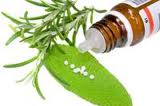
Salvia divinorum is a herb that, when ingested directly or dried and inhaled, can cause hallucinations or other delusions. One dangerous effect of the drug is a loss of a sense of reality, making it a particular concern if salvia is used while driving a vehicle.
Also Known As: Sally D, Magic Mint, Shepherdess’ Herb, Ska Maria Pastora, Diviner’s Sage, Sage of the Seers
MedTox Laboratory:

AABB – American Association of Blood Banks

Paternity, DOT and Drug Testing Springfield Missouri
Confidential testing is completed by certified laboratories for private individuals, treatment centers, courts and attorneys, concerned families, physicians, and legal representatives
SAMHSA:

Department of Transportation (United States):

Missouri Department of Transportation

www.modot.mo.gov
http://www.dontmethwithmo.com/
National Institute of Chemical Dependency


